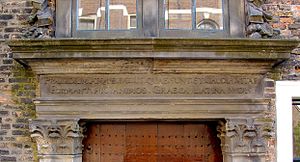
The Latin school was the grammar school of 14th- to 19th-century Europe, though the latter term was much more common in England. Other terms used include Lateinschule in Germany, or later Gymnasium. Latin schools were also established in Colonial America.
Emphasis was placed on learning Latin, initially in its Medieval Latin form. Grammar was the most basic part of the trivium and the Liberal arts. Latin schools aimed to prepare students for university, as well as seeking to enable those of middle-class status to rise above their station. It was therefore not unusual for children of commoners to attend Latin schools, especially if they were expected to pursue a career within the church.[1] Although Latin schools existed in many parts of Europe in the 14th-century and were more open to the laity, prior to that the Church allowed for Latin schools for the sole purpose of training those who would one day become clergymen.[2] Latin schools began to develop to reflect Renaissance humanism around the 1450s. In some countries, but not England, they later lost their popularity as universities and some Catholic orders began to prefer the vernacular.[3]